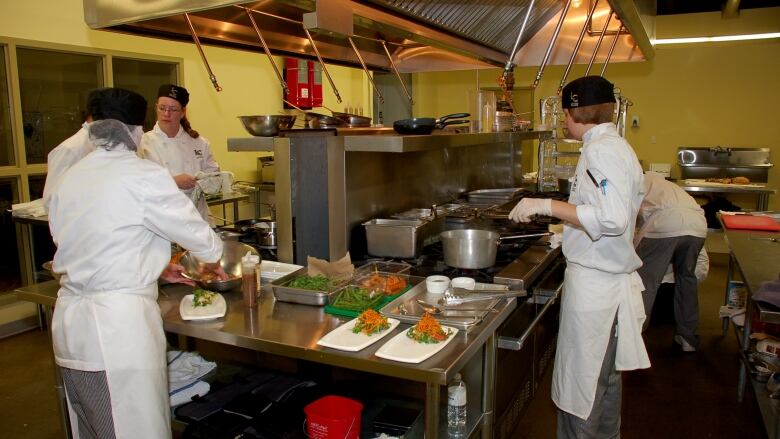How culinary schools plan a return to the kitchen during pandemic: Andrew Coppolino
'As battered as the industry is, cooks are still required,' says Stratford Chefs School instructor

Restaurants and food operations have struggled since the March shut-down and are trying to stay afloat as the industry slowly re-opens.
For culinary schools in the area, theory courses were relatively easy to complete virtually, but the pandemic has been an obstacle to the practical teaching of cooking skills where students needed to be side-by-side in school kitchens.
Keith Muller, chair of Conestoga College's School of Hospitality and Culinary Arts, says the hope is to be able to get back soon to full-time education on campus.
"After all, we are teaching a practical program," Muller said of the hands-on work in kitchens, where culinary students are evaluated.
Conestoga culinary students missed five weeks of their winter semester due to the shutdown and will be returning for an intensive three-week practical program at the Waterloo campus beginning August 10.
Theory classes had continued during the summer and moving forward those classes will remain online.
"But they will be doubling up all their practical courses and obviously with very strict protocols, including classes half the size for physical distancing," Muller says.

Expensive to run half-sized classes
Classes in the kitchens will now be set at 12 students. Muller hopes that number can increase this fall.
"It becomes more expensive to run a program with half-size classes," he said.
Before they enter the kitchens, students will be screened, they must wear personal protective equipment, they will follow directional arrows with controlled entry and access while on campus and they will not be allowed into a class if they are late. There will be no food service on campus.
Muller says enrollment has remained steady despite the pandemic.
"We don't know if our international students will be allowed to travel at this time," Muller says.
"Right now, the government is saying that they will not be allowed to travel unless they can prove that they have to be on campus for a practical-based program."
According to Muller, the biggest hit could come this fall semester.
"Things should improve by January, unless something else happens," he said. "I think it will be a year to 18 months before we stabilize completely. The important thing is the health of the staff and the students, so we can't rush into a full re-opening."
Smaller class sizes
Once the government command came to close down, Liaison College in Kitchener converted to online training almost immediately. For the practical cooking aspect, they followed Ministry guidelines and protocols and were able to get students behind the stoves to complete their year.
"There have been smaller numbers so we can keep proper distancing between them, but we don't normally have a large number of students in the class," said chef Elaina Kourie, director at Kitchener's Liaison College.
This fall, so far Liaison has full enrollment and usually accept between 12 and 16 students at the basic, "Cook 1" level, said Kourie.
"This is really shedding light on the industry as a whole and the fact that we have to do things a bit differently. Now more than ever we need well-trained professionals," Kourie said.
Money poses a problem for many sectors of the economy. Liaison traditionally accepts students, often with families, who have been forced to make a career change and need to re-train.
"People have lost jobs and they need to re-train but money is scarce and many cannot access the funds to train," Kourie says. "In the industry, we need to put our heads together and see what we can put into place as teaching institutions."
Demand for chefs still high
The Stratford Chefs School's winter term wrapped at the end of February, so students were able to complete their term. Right now, the school is running their 16-week summer program as a 13-week program.
Eli Silverthorne, an instructor and Open Kitchen program manager, says they've made changes, dropped some components and have a slightly smaller class size.
For the cooking components, seven students and an instructor are in the kitchen with recommended spacing and PPE, he says.
"That's how we will be setting up for the new fall term. It will be as close to the Stratford Chefs School program as possible," Silverthorne said.
Enrolment for fall will be down from about 35 to 21 new students, with about 20 returning students. Culinary theory classes will be either virtual or with instructors, at their choice.
"It's optional for instructors. I still teach two classes in person," Silverthorne added.
As for the money, a smaller cohort is manageable: the school spends a lot of money on cooking ingredients, so savings are possible.
"We can control costs by ordering less food for the fewer students to work with," Silverthorne said.
The school's dinner series at their restaurant will continue as another revenue source but in a smaller, distanced dining room.
"We're looking at building up our Open Kitchen program, too, and we've started doing take-out options as additional revenue sources," Silverthorne said.
By the nature of their unique and small program, students don't attend the school for the traditional college experience, according to Silverthorne.
"We haven't lost many professionally-driven people," he said. "As battered as the industry is, cooks are still required in restaurants and there's a demand for an increased skill set in the kitchen."
Corrections
- An earlier version of this story said Conestoga culinary students missed 10 weeks of their winter semester. It was in fact five weeks.Aug 05, 2020 11:05 AM ET